Key Points:
- Lake Tahoe is the clearest lake in the United States and also North America’s largest alpine lake in the Sierra Nevada mountains.
- Crater Lake is the deepest lake in the United States at almost 2,000 feet.
- Norris Lake is a reservoir with an associated dam on the Clinch River that provides valuable water storage, hydroelectric power, and flood control.
Most of the United States doesn’t live along the Pacific or Atlantic Coasts, but that doesn’t mean that there aren’t inland wonders and beautiful beaches. 14 of the clearest lakes in the US offer up an alternative paradise.
As with most bodies of water, the biggest threat to these natural resources is human development and debris left behind after recreational use. If you’re going to visit one of the clearest lakes in America, make sure to pack out everything that you packed in.
So where can you find some of the clearest lakes in the United States?
The 14 Clearest Lakes in the US
Here are 14 of the clearest lakes in the US:
- Lake Tahoe
- Hanging Lake
- Crater Lake
- Torch Lake
- Norris Lake
- Newfound Lake
- Flathead Lake
- Lake Chelan
- Lake Murray
- Lake Coeur D’Alene
- Lake George
- Lake Winnipesaukee
- Lake Powell
- Deer Lake
Let’s dive into each one in more detail!
1. Lake Tahoe in California and Nevada: The Clearest Lake in the United States
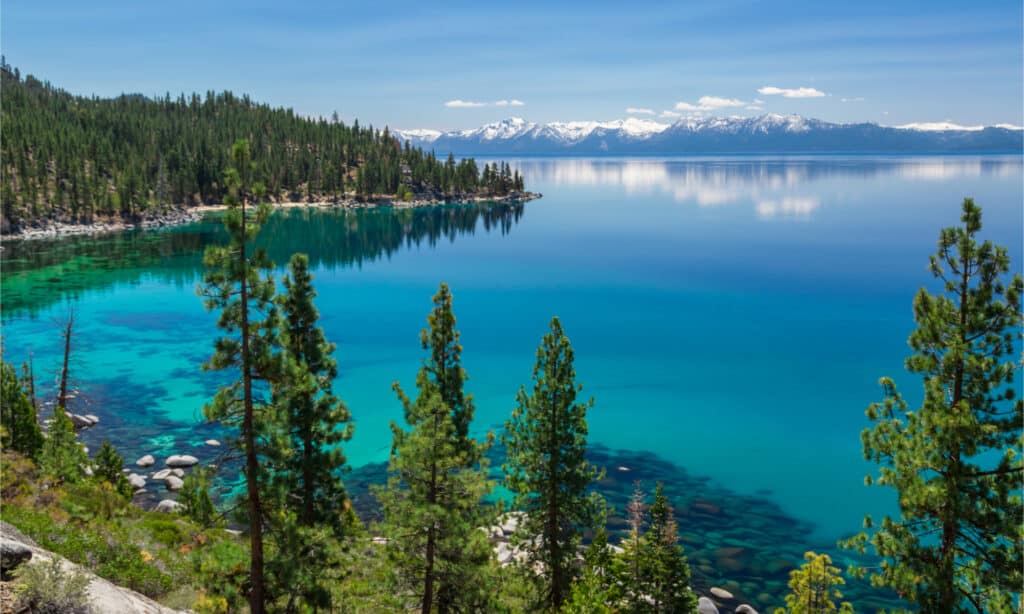
Lake Tahoe is the clearest lake in the United States.
©topseller/Shutterstock.com
Lake Tahoe is the clearest lake in the United States and also North America’s largest alpine lake in the Sierra Nevada mountains. It is over 1,600 feet deep and sits at an elevation above 6,000 feet. This makes it only the second deepest lake in the U.S. after Crater Lake in Oregon.
The waters are crystal clear making it one of the clearest lakes in the U.S. and this lake also has the purest water in North America. It’s a popular tourist spot with over 3 million visitors per year. Minerals that have dissolved in the water give it its characteristic turquoise hue.
Several species of fish live in the lake including bass (largemouth and smallmouth), bluegill, common carp, crappie (black and white), and trout (brown, and brook).
Fans of wildlife may also be able to spot bald eagles, bears, minks, and beavers in its environs.
2. Hanging Lake in Colorado

The clear Hanging Lake is perched on the edge of cliffs.
©iStock.com/Donyanedomam
This lake was created by limestone affected by a fault line. It’s perched on the edge of cliffs and fed by waterfalls.
The only way to access Hanging Lake is via a 3-hour hike on the Hanging Lake Trail. This lake is located on Dead Horse Creek above the Colorado River in the Glenwood Canyon.
Wetland habitats about in this unique environment. Black swifts, which live behind or near waterfalls, live at the Hanging Lake.
In 2020, a massive forest fire wiped out a lot of the surrounding area of Glenwood Canyon and its trails. Hiking to the Hanging Lake requires a permit but is still available, weather permitting.
The lake which is 25 feet at its deepest point, contains an abundance of rainbow trout and beavers can be seen taking a splash in the clear water.
However, neither fishing nor swimming are permitted at Hanging Lake owing to its rather delicate ecosystem.
3. Crater Lake in Oregon
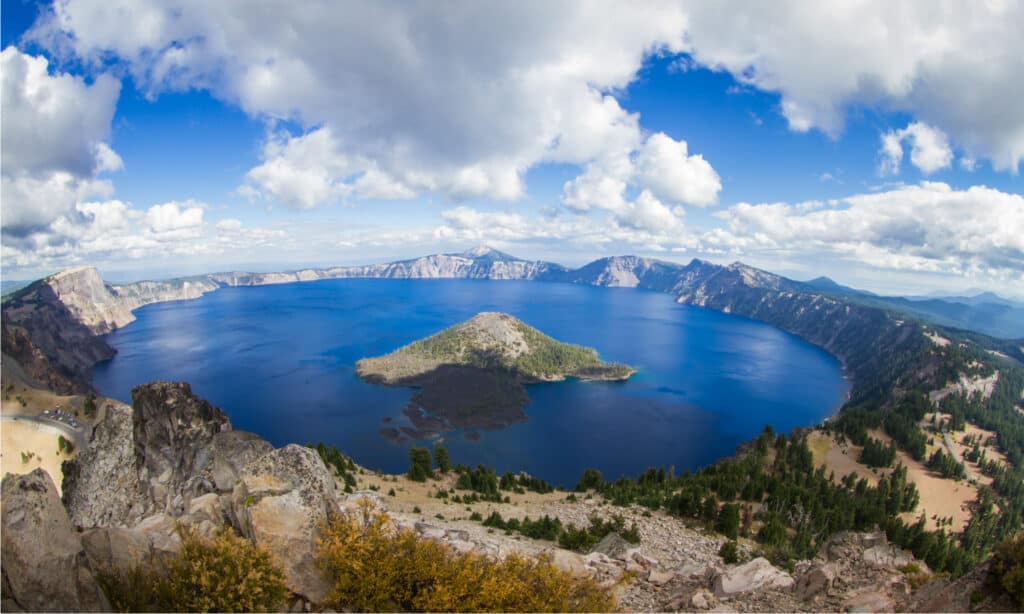
Crater Lake is clear because all of its water comes from precipitation.
©Wollertz/Shutterstock.com
Crater Lake is the deepest lake in the United States at almost 2,000 feet. About 7,700 years ago, a now dormant volcano erupted violently, and it created a huge caldera. That caldera is now full of clear water.
All the lake’s water is sourced from rain and snow runoff with no inlets. Because of this, there is no sediment or debris traveling into the lake. That’s one of the reasons it’s one of the clearest lakes in the United States.
So, is there anything at the bottom of Crater Lake? A tunnel through dead aquatic moss sits at the bottom. The dead moss layers accumulated over thousands of years and can reach 40 yards thick.
An interesting fact about this lake is the fact that it is believed to have never contained any native fish populations. The kokanee salmon, brook trout, brown trout, and rainbow trout which live in it were introduced artificially.
Bobcats, deer, elk, and squirrels can be seen in its environs busily searching for their next meal.
4. Torch Lake in Michigan

Torch Lake has clear turquoise waters that look almost Caribbean.
©AnotherViewDroneService/Shutterstock.com
There are 14 lakes in Michigan with the same river attached to them. This string of lakes is known as the Chain of Lakes. Their turquoise waters are reminiscent of the Caribbean.
Elevated copper levels may be disrupting the reproductive cycle of some fish in Torch Lake. The lake which has a depth of 285.4 feet, is home to coldwater species you’d find in similar lakes. Lake trout, lake whitefish, and deep-water sculpins are a few examples.
Lake herring and lake whitefish were studied during the winter when the lake is iced over. Their feeding behaviors hadn’t been observed before, and the crystal-clear waters of the lake afforded the chance.
Whitetail deer and porcupines constitute the most common form of mammalian wildlife in its environs.
5. Norris Lake in Tennessee

Norris Lake is a clearwater reservoir on the Clinch River.
©Bryan Busovicki/Shutterstock.com
Norris Lake is a reservoir with an associated dam on the Clinch River. The reservoir which has a depth of 210 feet, provides valuable water storage, hydroelectric power, and flood control.
Striped bass is stocked in the water for fishermen. Fish aren’t as abundant here because the lake doesn’t produce much of its own nutrients. What comes in from the Clinch and Powell rivers isn’t enough to sustain large fish populations.
There are black bass, crappie, walleyes, and sunfish in the lake.
6. Newfound Lake in New Hampshire
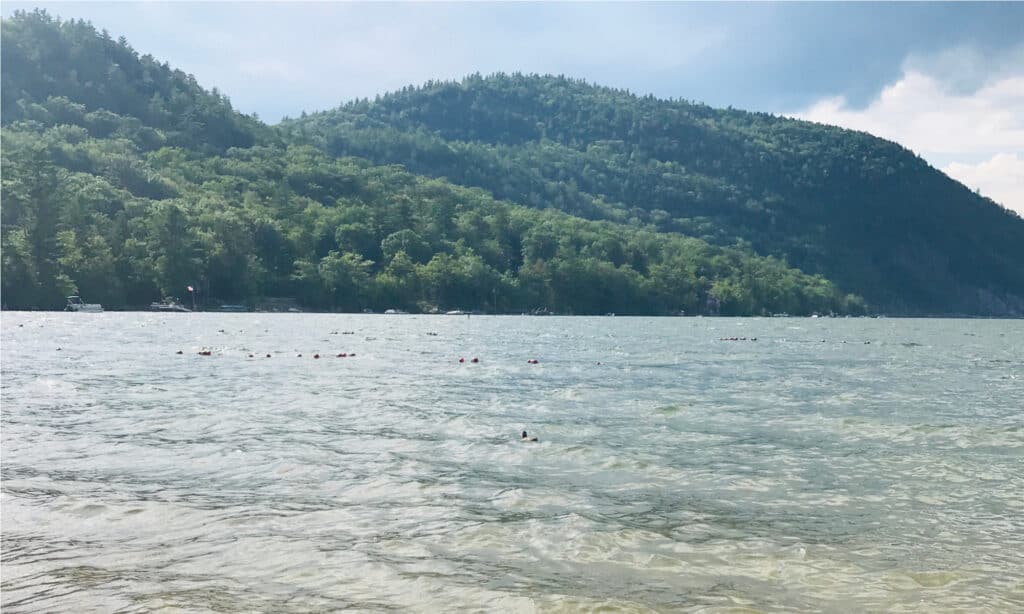
The clear water in Newfound Lake comes from 8 underground springs.
©Alison Leyton/Shutterstock.com
There are 8 underground springs that feed Newfound Lake. White round fish call this 183-foot-deep lake home after being stocked in the late 19th century. Newfound Lake has also been stocked with salmon while brook trout call it home. There is a lake trout hatchery.
This is a shallow lake compared to others on the list at 183 feet deep, but it is one of the deepest lakes in New Hampshire.
7. Flathead Lake in Montana
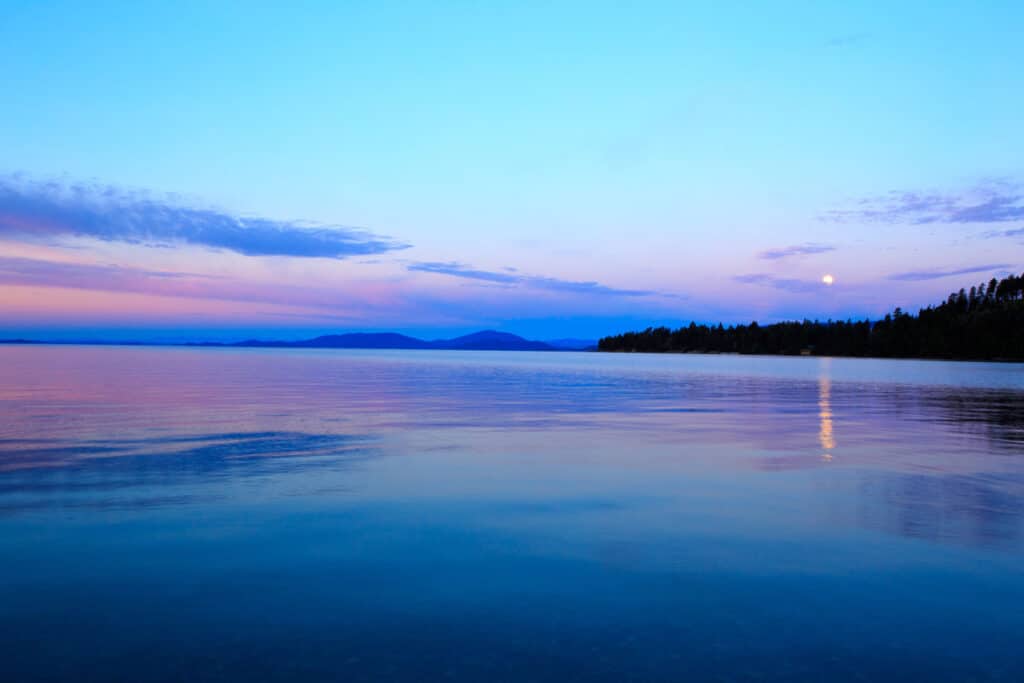
Flathead Lake in Montana has clear water and ample trout fishing opportunities.
©iStock.com/highmountainphotography
Wild Horse Island on Flathead Lake has a wildlife refuge that’s home to over 75 bird species, deer, bears, coyotes, and bighorn sheep.
Lake trout and bull trout are found in the lake which is 371 feet deep. Lake trout are invasive while bull trout are native, but the lake trout have been displacing the bull trout. Incentivized fishing programs were put into place to reduce the number of lake trout, but efforts are ongoing.
8. Lake Chelan in Washington
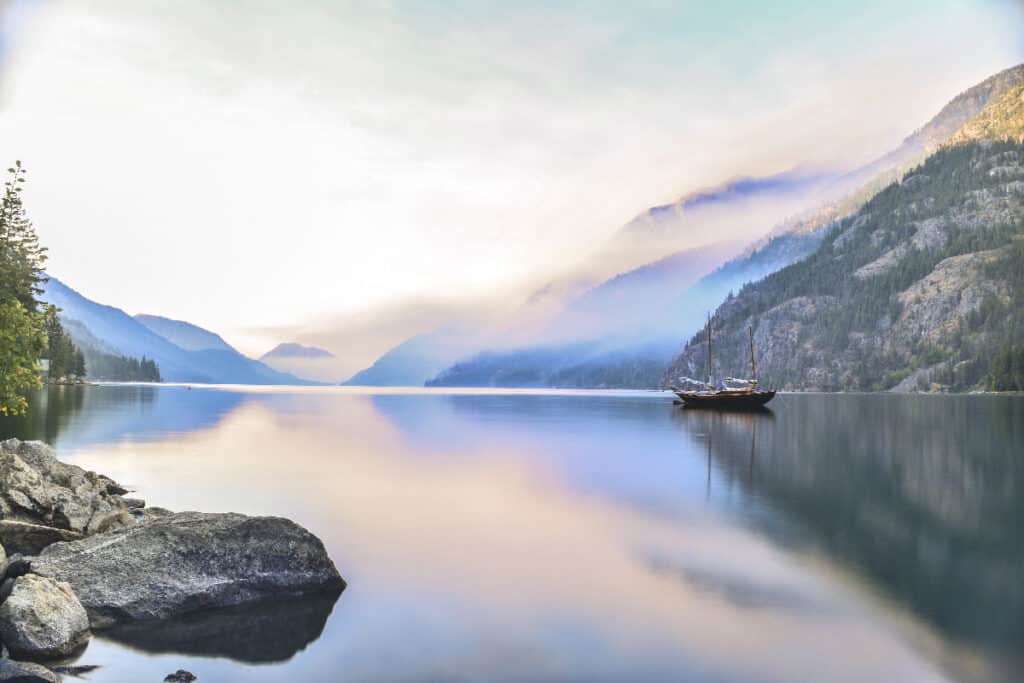
Lake Chelan is the 3rd deepest lake in the United States.
©iStock.com/jmacarthur
This is the 3rd deepest lake in the United States at over 1,400 feet — 1,486 feet, to be precise. Lake Chelan is another glacier-formed lake. The Stehekin River is its main feeder which flows out of the Cascade Mountains.
The Chelan River is its outlet which connects to the Columbia River. Lake trout and chinook salmon live in this lake.
Some of the birds that live in the immediate area of Chelan Lake are the cinnamon teal, the black swift, the white-throated swift, the calliope hummingbird, the Clarke crow, the western evening grosbeak, the western chipping sparrow, the red-eyed vireo, the Townsend warbler, the American redstart, the catbird, and the olive backed thrush.
9. Lake Murray in Oklahoma
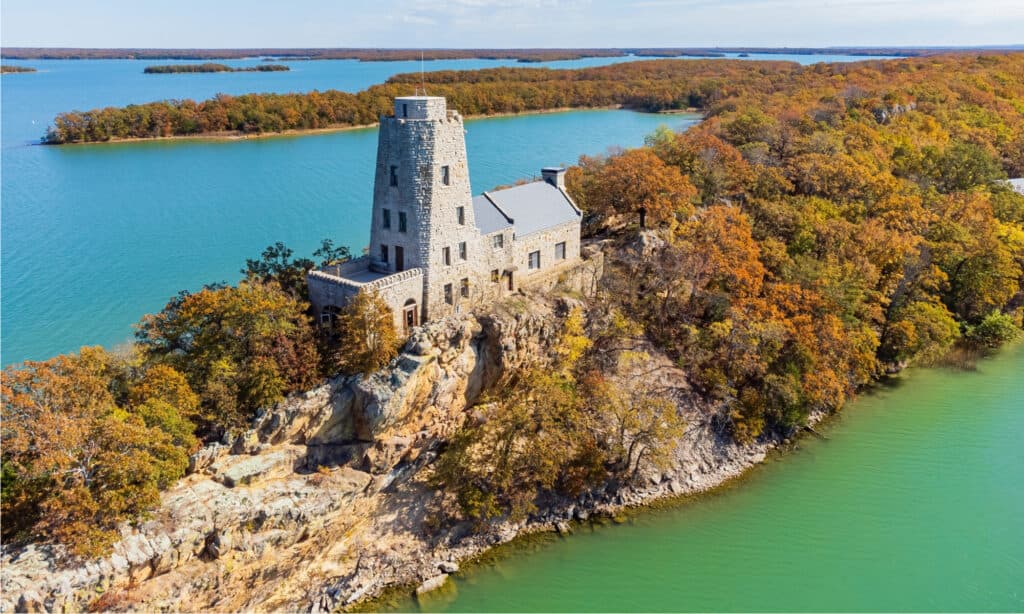
Even at the center of Lake Murray, the bottom is visible through the clear water.
©Kit Leong/Shutterstock.com
Even at the center of the lake, the bottom is visible. Lake Murray is in Lake Murray State Park, which is the largest state park in Oklahoma. The Fourche Maline and Anadarche creeks were dammed to create this lake which is 98 feet deep.
The dam is an earthen dam, and the lake was created for recreational use.
10. Lake Coeur d’Alene in Idaho

The water in Lake Coeur d’Alene is clear enough to see 15 feet deep.
©James Sakaguchi/Shutterstock.com
You can see at least 15 feet down through the clear water in this lake which is actually 220 feet deep. This part of Idaho has over 50 lakes due to glacial movement and melting during the last ice age.
A 3,300 ft. long floating boardwalk in Lake Coeur d’Alene is the biggest on earth.
11. Lake George in New York State

Salt used on roads in the winter was affecting the clear waters of Lake George.
©majicphotos/Shutterstock.com
Underground springs feed the lake and it is why Lake George is one of the clearest lakes in the United States. There are over 300 islands in this 197-foot-deep lake most of which have either campgrounds or hotels.
Road salt used on roads in the winter tripled the salinity of the lake. Efforts to use less salt on roads in developed areas around the lake help alleviate the problem.
12. Lake Winnipesaukee in New Hampshire

New Hampshire’s largest lake is Lake Winnipesaukee.
©iStock.com/Gerry Fagan
New Hampshire’s largest lake is Lake Winnipesaukee.
If you’re into the macabre, the Lake Winnipesaukee area has a deep and well-recorded history with cemeteries. There are numerous cemeteries around the lake with headstones made from stones sourced from Lake Winnipesaukee which itself is 214 feet deep.
13. Lake Powell in Arizona and Utah
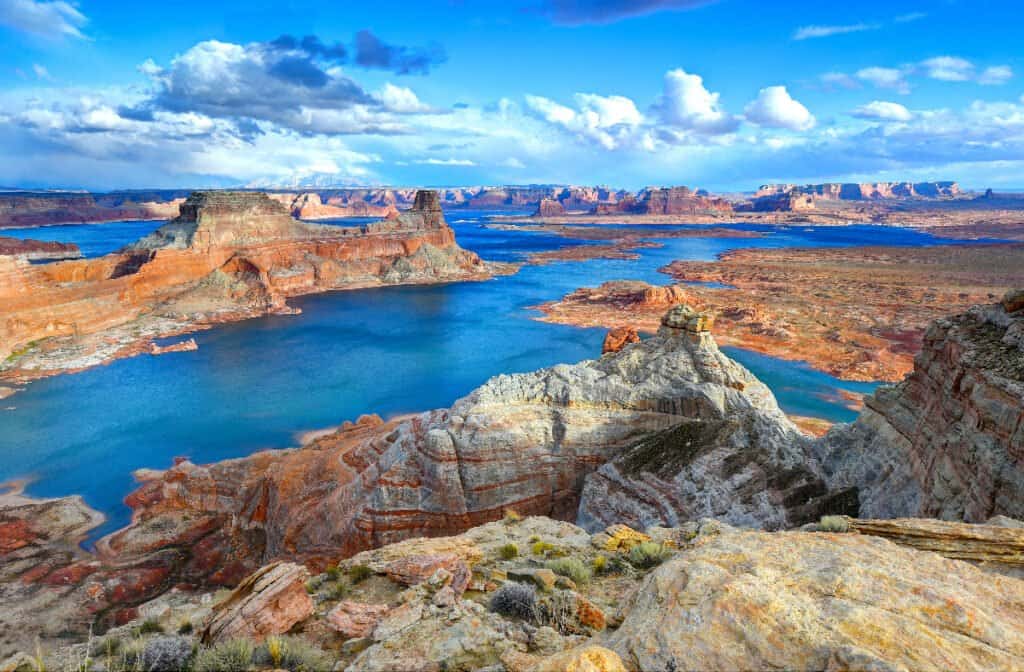
Lake Powell is vulnerable to invasive species.
©worldswildlifewonders/Shutterstock.com
This is a 558-foot- deep reservoir in Glen Canyon on the Colorado River.
The quagga mussel, which is an invasive species in Lake Powell, may change ecosystem dynamics through its presence. The long-term implications caused by the cascade effect of these mussels are to be determined.
There is also evidence that the grass carp is settling in, which is another invasive species that could cause major issues.
14. Deer Lake in Minnesota

Minerals in the clear water of Deer Lake make it turquoise.
©Dan Thornberg/Shutterstock.com
This lake has no inlets and is produced through springs and runoff from rainfall. The Deer River flows from the lake.
There are minerals in the soil and rocks that make up the lake which makes the water turquoise. You can see about 13 feet deep down in this lake which is 331 feet deep.
Fishing is popular here, with fishermen looking for smallmouth bass and walleyes. There are baitfish in the water such as yellow perch.
Summary of 14 of the Clearest Lakes in the US
| Rank | Location | Lake | Depth |
|---|---|---|---|
| 1 | California/Nevada | Lake Tahoe | 1,600 feet |
| 2 | Colorado | Hanging Lake | 25 feet |
| 3 | Oregon | Crater Lake | 1943 feet |
| 4 | Michigan | Torch Lake | 285.4 feet |
| 5 | Tennessee | Norris Lake | 210 feet |
| 6 | New Hampshire | Newfound Lake | 183 feet |
| 7 | Montana | Flathead Lake | 371 feet |
| 8 | Washington | Lake Chelan | 1, 486 feet |
| 9 | Oklahoma | Lake Murray | 98 feet |
| 10 | Idaho | Lake Coeur D’Alene | 220 feet |
| 11 | New York | Lake George | 197 feet |
| 12 | New Hampshire | Lake Winnipesaukee | 214 feet |
| 13 | Utah/Arizona | Lake Powell | 558 feet |
| 14 | Minnesota | Deer Lake | 331 feet |
The photo featured at the top of this post is ©
Thank you for reading! Have some feedback for us? Contact the AZ Animals editorial team.






